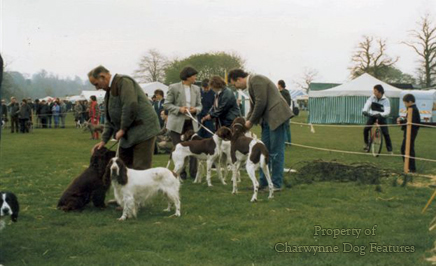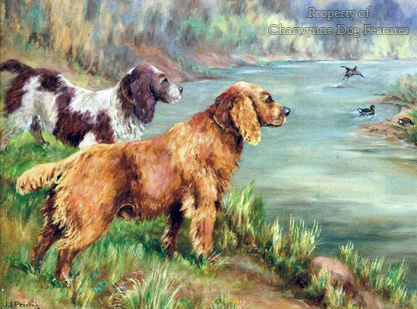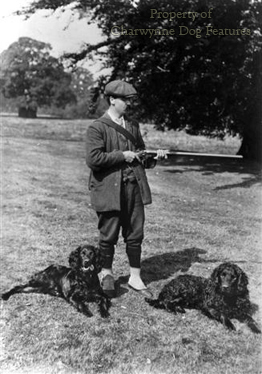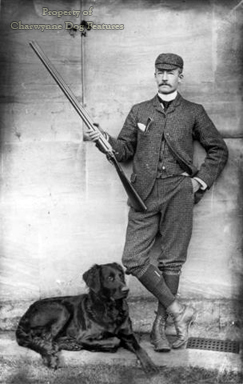496 Shooting Dogs
SHOOTING DOGS
by David Hancock
 Dogs developed to support game shooting have long proved to be not only superb gundogs but admirable companion dogs too. Of all the groups of dog fashioned by man, the gundog group can make a claim too to embrace the most handsome breeds available. Breeds like the Golden and Flat-coated Retrievers have glamour and charm, the Pointer has sheer style, the setters combine usefulness with handsomeness and the spaniels display energy and enthusiasm, as well as good looks. Gundog breeds introduced more recently, like the Weimaraner, the Vizsla, the Munsterlander, the GWHP and the Brittany, have perpetuated this combined appeal of utility and cosmetic distinction. All these good-looking valuable breeds developed in line with man's sporting preferences, with the retrievers coming later, as breeds, to meet a specific need.
Dogs developed to support game shooting have long proved to be not only superb gundogs but admirable companion dogs too. Of all the groups of dog fashioned by man, the gundog group can make a claim too to embrace the most handsome breeds available. Breeds like the Golden and Flat-coated Retrievers have glamour and charm, the Pointer has sheer style, the setters combine usefulness with handsomeness and the spaniels display energy and enthusiasm, as well as good looks. Gundog breeds introduced more recently, like the Weimaraner, the Vizsla, the Munsterlander, the GWHP and the Brittany, have perpetuated this combined appeal of utility and cosmetic distinction. All these good-looking valuable breeds developed in line with man's sporting preferences, with the retrievers coming later, as breeds, to meet a specific need.
A rough-shooter's dog needs wide-ranging skills, a wildfowler's dog needs the constitution and coat to ensure its mere survival. Battue shooting demands great marking talents and the softest of mouths, so that even the tiredest dog does not mark its game. Historically, game was shot by being walked up, the quarry being shot as it flew or ran away. But, in the early/mid 1800s, sparked by the introduction of breech-loaders, a major change occurred. The guns remained stationery whilst the birds were driven over them by beaters. This style brought a great demand for retrievers and initiated the immense popularity of breeds like the Labrador and the Goldie. It also resulted in quite staggering numbers of game birds being shot.
Battue or driven game shooting seems to have been first introduced at Knowsley in the mid 1820s by the 12th Earl of Derby. One of his guests, the Viscountess Belgrave, related that the total bag for the 1825 season came to 27,000 head of game. In one shoot at Elveden in Suffolk on the 5th of November 1912, five guns brought down 2,507 pheasants and 806 partridges. At Hall Barn in Buckinghamshire on December 18, 1913, seven guns shot a bag of 3,937 pheasants. More recently, in one day's shooting at Broadlands in 1968, 2,139 pheasants were shot, Prince Charles alone accounting for 500 of them. If every bird on each of these days was retrieved by a dog, just imagine the stamina required, in such a short space of time .
.
We write about gundogs needing sound anatomies, stressing the importance of shoulders, loins and limbs, but the sheer enthusiasm and utter determination required by the dogs during such intense activity, is awesome. Sportsmen too were not always the best dog-owners. In his renowned sporting diaries, the strangely revered Colonel Hawker writes on the 31st of October 1814: "The infamous behaviour of my water-dog spoiled all my amusement...I finished my day with shooting the dog, at the express wish of Mrs Hawker and to the general satisfaction of all who were with us." This disgraceful unforgivable act gives a whole new meaning to the descriptive expression 'dogs for shooting'! But truly can you expect more from a man who shot swans, wheatears, short-eared owls, fieldfares and woodpeckers, and found it amusing to call the gun he used to dispatch maimed birds, his 'cripple-stopper'.
Gundogs have always been at the mercy of single-minded so-called sportsmen. There was a shameful incident at a Pointer trial a decade or so ago, when one handler, disappointed by his dog's performance, suspended the animal on a choke chain and swung it through the air. 'Breaking' gundogs was for centuries the term used for their training. In his book Dog Breaking, of 1909, General WN Hutchinson writes: "Consider coolly whether you are flagellating a thick-coated dog, or one with a skin not much coarser than your own. Pause between each cut; and that he may comprehend why he is punished...let your last strokes be milder and milder, until they fall in the gentlest manner..." Perhaps those final words tempted the General's son, in a later preface to claim: "It is far less common than it used to be to see a dog brutally ill-treated, and I venture to think that the principles inculcated by my father in these pages have gone far to create a more intelligent sympathy between man and dog..."
It is depressing to hear from someone who has sent his young gundog away to a professional trainer for 'special gundog training' that the dog has returned cowed, spiritless and fearful of even a slightly raised hand. Most dogs want to work; they need direction more than correction. In his perceptive Gundog Sense and Sensibility (Pelham Books, 1982) Wilson Stephens writes: "For me, physical discipline is largely an uncharted area. Whenever possible, therefore, I seek to make my impression more directly on the mind. In this process the trainer has a valuable and negotiable asset in the confidence, even love, which the dog has come to place in him. I prefer to work on that..." I daresay that Colonel Hawker's water-dog was wagging its tail with misplaced confidence when he shot it.
But it is depressing too to see essentially functional dogs, like gundogs, displaying so many faults in the show ring. Such basic faults as upright shoulders, weak loins, slab-sidedness and a lack of drive from the rear would seriously handicap a gundog in the shooting field, where function once decided form. Judges's critiques from recent shows illustrate the basic flaws in so many gundogs proudly exhibited by their owners. Irish Setters: "Front movement crossed, plaited and hackneyed, this is due to badly constructed front assemblies, upright shoulders, narrow fronts and no depth of chest. Rear movement was appalling." Gordon Setters: "Movement in general was disappointing; close hind movement and lack of drive." Another judge in this breed reported: "I want to see some rib and substance, some forechest and heartroom...I found more than a few bitches with lack of heartroom and loose elbows..."
For any gundog breed to lack a working physique is disappointing to say the least; are we promoting glamour ahead of soundness? Dogs don't care what they look like, but they do suffer distress when we expect them to run and run with little lungroom in their thoraxes, limited forward extension in front and a lack of power from the rear. A Pointer judge reported in a recent critique: "The breed as a whole now seems to be suffering from poor hindquarters, ranging from straight stifles, no definition of hock joint, hocks set too high, poor width of thigh, steeply sloping croups...if we lose the powerful back-ends our Pointers will no longer have the drive to propel them over the moors and stubble fields to enable them to do the job for which they were bred."
It is difficult to identify the logic in favouring a breed designed for a specific purpose, and therefore having the anatomy suitable for that, then breeding specimens to an alien design. Many Pointers that I see, even at Crufts, are quite unlike those depicted in past centuries; they lack substance, physically they are not sound gundogs, with narrow chests, straight shoulders and poor movement. This saddens me, these were once superlative hunting dogs, famous in many countries for their prowess in the shooting field. I once watched a Pointer win at Crufts with a Hackney action, a feature forbidden in its breed standard. This is a standard which uses just three words on the stifles, stating that they must be 'well-turned'. Is such judging and such a word picture helping this distinguished breed?
The great Pointer expert, William Arkright, in his The Pointer and his Predecessors, of 1906, wrote: "The Stifles, extending from the stifle-joint to the hock, must be well bent, since on the length of the outline of his hindquarters, between the hip-bones and the hocks, will depend the endurance of the dog, as this formation, in conjunction with an arched loin, gives the maximum of speed with the minimum of labour..." I find those words valuable. Breed standards should be reasonably brief, but to devote just three words to the stifle does not give sufficient guidance to tyro-breeders. This is a justly famous British gundog breed, deserving the very best custodianship.
In his informative The Setter, of 1872, the great setter pioneer-breeder Edward Laverack gave his views on the 'formation of this breed', including these words: "...chest deep, wide, and ribs well sprung behind the shoulders...A setter should not rise or be too upright in the shoulder..." I don't see many wide-chested setters nowadays, most are noticeably slab-sided, which limits their lungroom considerably. The Crufts judge of Irish Setters in 2001 wrote: "On the whole I was very disappointed with the quality of the dogs. Narrow fronts, lack of bone, upright shoulders, narrow chests with no heart or lungroom, weak backends, poor movement. I would be very surprised if many of these could work as a gundog, the job for which they are bred."
The year before at Crufts, the English Setter judge recorded: "Many of the dogs that were quite nice standing fell apart on the move." The movement of any setter should be a joy to behold: flowing effortless controlled power. It is more than disappointing for 'the best of the very best', as the Kennel Club describes the Crufts entry to be, so inadequate. Perhaps the stock of the gifted working setter breeder Derry Argue has a role in improving the breed. His Llewellin Setters are exported to knowledgeable overseas clients but are largely unknown to the show world. The Americans still keep the Llewellin blood separate and preserve it. We have lost the chalk-white Llanidloes Setter and never persevered with the Russian Setters once imported.
In his book, Laverack describes the Russian Setter as very high-couraged but obstinate, only kept in order and subjection by a large quantity of work and whip. He recounts how one owner was so disgusted with two of his dogs that he shot one and gave the other away. These dogs were credited with having 'an enormous quantity of long silky white hair' and you do see some over-coated heavily furnished specimens in the show ring, but never in working stock. Setters are a most important element in our sporting dog heritage and it would be a disaster if they lost their functional anatomy in the pursuit of show ring success. The functional anatomy is the soundest one, developed in a hard school and when devalued soon degrades a breed.
Birddog-work may have been lessened by shifts in sporting preferences, but retriever-work, especially with Labradors and Goldens, and spaniel-work, particularly with English Springers, has actually expanded. The enormous success of these breeds may have led to some loss of true type but their success has been well justified. They are the favoured breeds of shooting men, despite the merits of the HPR breeds, now established here. Over-popularity has ruined many a breed and both the Lab and the Springer community need to be vigilant. We need too to support the minor spaniel breeds; I saw much to admire in the Field Spaniels of the late Clive and of Pam Rowlands, perpetuating the famous Rhiwlas line, and the working Clumbers of James Darley and the Zuricks.
The shooting fields of Britain have bequeathed us some superlative sporting dogs and given to a wider world deservedly popular companion dogs. Before the invention of firearms, such dogs were retrieving duck and even spent bolts and arrows from water, enticing wildfowl into cages and 'freezing' game-birds so that nets could be cast over could be cast over them. They have indicated unseen quarry, put up game, flushed it, marked it, located it, retrieved it and delivered it to hand. In the past they have been whipped for getting it wrong, sometimes even shot. And now the use of electric collars has given them a new, and to me, unwanted experience. As always a man's treatment of his dogs tells you a lot more of him than of his dogs.
I treasure my memories of a few brief hours spent with part-time gamekeeper the late Clive Rowlands on a nearby estate with his busy energy-packed Field Spaniels. They were like little tanks in the way they penetrated the dense local cover. But even more noticeable was their rapport with their owner, whom they could not see; dog and man working in complete harmony. I recall with pleasure too the first time I saw, in Germany, the all-rounders at work, the hunt-point-retrieve breeds in action. Wrongly described as utility gundogs, their skills are wide-ranging and demand much from a handler. Thankfully I know of no instance in which one has been shot by an intolerant owner but, if shooting becomes a new 'welfare' issue, some could well be. For over a thousand years these dogs have adapted to man's needs; I do hope we keep theirs in mind. Our training methods may now be more enlightened, I do hope our empathy is too.